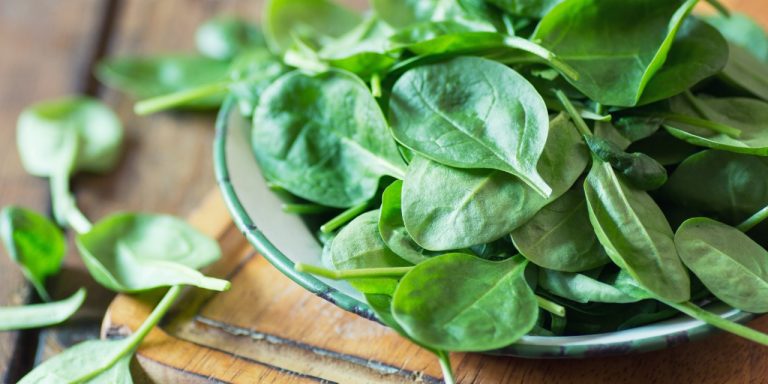
Folic acid: what are the benefits?
Why do our bodies need folic acid? How much folic acid do you need when trying to conceive and during pregnancy? What are the symptoms of folic acid deficiency? Find out why folic acid is important and which foods are rich in folate.
Folic acid: what is it?
People often use the term “folic acid” when they mean “folate”. Folate is a water-soluble vitamin also known as vitamin B9. Folate is found in plant-based and animal foods (dietary folate) – for instance in kale, spinach or hens’ eggs. Folic acid is the synthetically produced form of the vitamin. Our body does not produce folate and folic acid itself and can only store limited amounts of it. That means it is important to get it from our diet.
It’s worth noting that the human body absorbs folate and folic acid with differing degrees of success: we only absorb around 50% of folate from food. This figure rises to 85% in foods which have been artificially enriched with folic acid. We absorb 100% of folic acid when taken in the form of tablets, capsules or effervescent tablets. That is why you will often find the label “dietary folate equivalent” on food supplements and foods enriched with folic acid. 1 microgram of folate equivalent equals:
- 1.0 microgram of dietary folate
- 0.5 micrograms of folic acid in galenic form (tablets, capsules, effervescent tablets)
- 0.6 micrograms of folic acid added to food
In other words, we need to take on board significantly more natural folate to ensure our body gets as much of the vitamin as it would from artificial folic acid.
What does folic acid do?
Why do we need folic acid? Folic acid is essential for various processes in the body. It is responsible primarily for cell division and thus for the body’s growth processes. It also plays a role in the formation of red and white blood cells. Folic acid also influences iron and vitamin B12 metabolism.
What is the recommended daily folic acid intake?
Getting enough folic acid from our food is not easy, but you can counter the risk of folic acid deficiency with a healthy, varied diet. Folic acid requirements are not the same for everyone. Find out here how much folic acid you need daily:
- Dietary folate equivalent for adults: 300 micrograms a day
- Dietary folate equivalent when trying to conceive: an additional 400 micrograms a day
- Dietary folate equivalent in pregnancy: 550 micrograms a day
- Dietary folate equivalent for breastfeeding women: 450 micrograms a day
A higher dose is recommended for women trying to conceive. You need more folic acid during pregnancy too. In such cases, you should discuss your intake and dose with your gynaecologist.
Can you take too much folic acid? There are no known cases of overdosing from naturally occurring folate. However, caution is advised when taking folic acid in the form of food supplements: you should not exceed 1000 micrograms of folic acid a day. Consult your doctor if you are taking food supplements with folic acid. This will ensure you avoid any overdose. A folic acid overdose can cause various symptoms such as a loss of appetite, nausea, flatulence or a bitter taste. However, these only occur if you have been taking too much folic acid for an extended period.
Folic acid deficiency: causes
What is folic acid deficiency? Your body is deemed to have too little folic acid if your blood folic acid levels are below two nanograms per millilitre. By way of comparison, a normal value for adults is at least three nanograms per millilitre. Potential causes of folic acid deficiency include:
- Malnutrition
- Taking medication such as antiepileptics
- Pregnancy and breastfeeding
- Alcoholism
- Chronic inflammatory bowel conditions such as Crohn’s disease
- Metabolic disorders
- Old age
Folic acid deficiency: symptoms and consequences
Folic acid is essential, which is why it’s also referred to as the “vitamin of life”. Folic acid deficiency can involve a wide range of symptoms. Men and women experience the same symptoms.
- Weakness and fatigue
- Paleness
- Susceptibility to infections
- Respiratory problems
- Reddened tongue that feels like it’s burning
- Problems concentrating
- Diarrhoea
- Irritability and depression
- Loss of appetite
Embryonic abnormalities
Folic acid helps our cells to split and function properly. That is what makes an adequate supply of folic acid so important in pregnancy. Folic acid deficiency in pregnancy increases the risk of abnormalities in the embryo’s central nervous system. A well-known example is the “open” back in newborns (spina bifida; neural tube defect). That is why experts recommend taking folic acid in the form of food supplements before and during pregnancy. How long before pregnancy should you start taking them? According to experts, women who want to conceive should start taking folic acid no later than four weeks prior to pregnancy.
How does folic acid benefit men? Folic acid is important for sperm quality. Under some circumstances, folic acid deficiency may lead to sperm cells being less mobile and slower. Men with reduced fertility may even benefit from folic acid: in some cases, it boosts sperm count.
Anaemia
One potential side effect of folic acid deficiency is anaemia. What does folic acid do in this context? Folic acid plays a key role in the formation of red blood cells. These transport oxygen through the body and supply organs and tissues with it. In many cases, a lack of blood cells can result in weakness, fatigue and breathlessness. These are typical symptoms of folic acid deficiency.
Arteriosclerosis
Folic acid deficiency can lead to increased levels of homocysteine – a specific amino acid – in the blood. This increases the risk of arteriosclerosis in the cardiac and cerebral vessels. This predominantly affects people later in life. Folic acid deficiency during the menopause increases the risk of cardiovascular diseases.
Depression
Scientists suspect a link between folic acid and mental health. In some cases, folic acid deficiency increases the risk of depression. That is why specialists often use folic acid when treating depression. Other symptoms of folic acid deficiency connected to mental health include increased irritability, mood swings, problems with concentration and confusion.
Skin ageing
Folic acid plays an important role in cell division. Since skin cells renew particularly quickly, the effect of folic acid also impacts the skin. That’s because folic acid helps to maintain the protection of the top layer of skin. If it’s lacking, this protective layer loses its elasticity. Skin develops wrinkles more quickly.
Weight loss
What else does folic acid deficiency do to the body? Folic acid deficiency leads to a loss of appetite and, as such, in many cases, to weight loss. Weight gain, conversely, is not associated with folic acid deficiency.
Hair loss
Folic acid deficiency may lead to hair loss: folic acid stimulates hair growth by promoting cell division and growth. If it is lacking, hair loss can sometimes occur.
Preventing folic acid deficiency through diet
People need folic acid. So what is the best way to get enough? Ideally you should consume a sufficient amount of folate through food. You should also make sure that folate-rich foods are prepared gently: folate is water-soluble and sensitive to light and heat. Ensure you use folate-rich food as soon as possible after buying it and prepare it carefully – with minimal heat and water.
Foods containing folate
Folate is found in a number of different foods. A varied diet will ensure your needs are met. Below is a list of different foods that contain a lot of folate:
|
|
|
|---|---|
|
|
|
|
|
|
|
|
|
|
|
|
|
|
|
|
|
|
|
|
|
|
|
|
|
|
|
|
|
|
|
|
|
|
|
|
|
|
|
|
|
|
|
|
|
|
|
|
|
|
|
Food
Folate content (guideline values in micrograms per 100g)
Wheat bran
195
Wheat germ
143
Walnuts
137
Spinach (raw)
121
Chickpeas (cooked, without any added fat or salt)
88
Cabbage (average, raw)
73
Sour cherries
75
Wholemeal rye flour
70
Broccoli (raw)
69
Green salad (average)
68
Pumpkin seeds
58
Soya beans (cooked, without any added fat or salt)
50
Hazelnuts
41
Peas
40
Strawberries
31
Lentils (whole, cooked, without any added fat or salt)
28
Orange
18
You can also find many foods that enriched with folic acid in shops. These include bread, snacks and drinks. They are identified with the folic acid label and are available in health food shops, smaller grocery shops and supermarkets.
Recipe ideas for getting more folate in your diet
From steamed pak choi to cabbage roulade to broccoli pesto: you can find dishes that are high in folate in the Helsana Coach app. Download now.
Folic acid as a food supplement
Why do we need folic acid preparations? Folic acid is important for those hoping to conceive. Folic acid is also extremely important for pregnant women. In such cases, specialists recommend taking additional folic acid in addition to a balanced diet. Folic acid tablets should ideally be taken in the first three months of pregnancy. Be sure to consult your doctor in advance.
Folic acid performs key functions in your body. You can get your recommended intake with a balanced diet. Eat at least three portions of vegetables, wholegrain and dairy products every day and make sure that you choose a gentle method of cooking. Talk to your doctor if you think you might be experiencing symptoms of folic acid deficiency.

The expert provided the editorial team with advice and input for this article. Julia Pieh (doctorate in pharmacy and toxicology, pharmacist, naturopath) works in the Helsana Health Consultation Service.


Newsletter
Find out more about current health issues every month and get all the information you need about our attractive offers from all Helsana Group companies * delivered by e-mail to read whenever it suits you. Our newsletter is free of charge and you can sign up here:
We did not receive your information. Please try again later.
* The Helsana Group comprises Helsana Insurance Company Ltd, Helsana Supplementary Insurances Ltd and Helsana Accidents Ltd.
